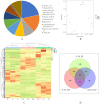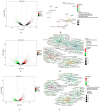Integrated Transcriptomic and Targeted Metabolomic Analysis Reveals the Key Genes Involved in Triterpenoid Biosynthesis of Ganoderma lucidum
- PMID: 39852476
- PMCID: PMC11767136
- DOI: 10.3390/jof11010057
Integrated Transcriptomic and Targeted Metabolomic Analysis Reveals the Key Genes Involved in Triterpenoid Biosynthesis of Ganoderma lucidum
Abstract
Ganoderma lucidum is a traditional Chinese medicinal fungus, and ganoderma triterpenoids (GTs) are one of the main bioactive compounds. These compounds have various pharmacological functions, including anti-tumor, antioxidant, anti-inflammatory, liver-protective, and immune-regulating effects. However, the manner in which they accumulate, and their biosynthesis mechanisms remain unclear. To screen for the genes that are involved in the biosynthetic pathway of GTs, this study analyzed the differential metabolites and differentially expressed genes (DEGs) among different growth stages of G. lucidum, including the primordia (P), the matured fruiting body (FM), and the post-spore fruiting bodies (FP) using targeted metabolomics and transcriptomics analysis, respectively. The results showed that a total of 699 components were detected, including lignans, terpenoids, amino acids and derivatives, and phenolic acids, among others. Among them, a total of 112 types of triterpenes were detected. Compared with the primordia, there were eight differential metabolites of triterpenoids, with three decreasing and five increasing in the FM stage. A comparison between the FM stage and the FP stage revealed that there were 13 differential metabolites of triterpenoids. A transcriptomics analysis showed that there were 371 DEGs in the P_vs_FM group, including 171 down-regulated genes and 200 up-regulated genes. In the FM_vs_FP group, 2567 DEGs were identified, with 1278 down-regulated genes and 1289 up-regulated genes. Through targeted metabolomics and transcriptome correlation analysis, six TFs and two CYP450s were significantly associated with four triterpenoid components. The results showed that these TFs and CYP450s were positively or negatively correlated with the four triterpenoid components. In addition, interestingly, some flavonoids and phenolic compounds, which have been reported in plants, were also detected in G. lucidum, indicating that it has the potential to be engineered into a strain capable of synthesizing flavonoid compounds. This study provides useful information about key genes involved in GT biosynthesis, but further exploration and in-depth research are needed to better understand the functions of these genes.
Keywords: Ganoderma lucidum; correlation analysis; ganoderic triterpenoid; targeted metabolomic analysis; transcription factors; transcriptomic analysis.
Conflict of interest statement
The authors declare no conflicts of interest.
Figures





Similar articles
-
Integrative Analysis of Selected Metabolites and the Fungal Transcriptome during the Developmental Cycle of Ganoderma lucidum Strain G0119 Correlates Lignocellulose Degradation with Carbohydrate and Triterpenoid Metabolism.Appl Environ Microbiol. 2021 Jun 11;87(13):e0053321. doi: 10.1128/AEM.00533-21. Epub 2021 Jun 11. Appl Environ Microbiol. 2021. PMID: 33893114 Free PMC article.
-
Transcriptome profiling of transcription factors in Ganoderma lucidum in response to methyl jasmonate.Front Microbiol. 2022 Nov 24;13:1052377. doi: 10.3389/fmicb.2022.1052377. eCollection 2022. Front Microbiol. 2022. PMID: 36504766 Free PMC article.
-
Enhanced production of polysaccharides and triterpenoids in Ganoderma lucidum fruit bodies on induction with signal transduction during the fruiting stage.PLoS One. 2018 Apr 25;13(4):e0196287. doi: 10.1371/journal.pone.0196287. eCollection 2018. PLoS One. 2018. PMID: 29694432 Free PMC article.
-
[Biosynthesis of ganoderic acid and its derivatives].Zhongguo Zhong Yao Za Zhi. 2025 Mar;50(5):1155-1163. doi: 10.19540/j.cnki.cjcmm.20241215.105. Zhongguo Zhong Yao Za Zhi. 2025. PMID: 40350898 Review. Chinese.
-
Chemodiversity, pharmacological activity, and biosynthesis of specialized metabolites from medicinal model fungi Ganoderma lucidum.Chin Med. 2024 Mar 22;19(1):51. doi: 10.1186/s13020-024-00922-0. Chin Med. 2024. PMID: 38519991 Free PMC article. Review.
Cited by
-
Integrative Transcriptome and Metabolome Analysis Reveals Candidate Genes Related to Terpenoid Synthesis in Amylostereum areolatum (Russulales: Amylostereaceae).J Fungi (Basel). 2025 May 16;11(5):383. doi: 10.3390/jof11050383. J Fungi (Basel). 2025. PMID: 40422717 Free PMC article.
References
-
- Sułkowska-Ziaja K., Balik M., Szczepkowski A., Trepa M., Zengin G., Kała K., Muszyńska B. A Review of Chemical Composition and Bioactivity Studies of the Most Promising Species of Ganoderma spp. Diversity. 2023;15:882. doi: 10.3390/d15080882. - DOI
-
- Ryu D.H., Cho J.Y., Sadiq N.B., Kim J.C., Lee B., Hamayun M., Lee T.S., Kim H.S., Park S.H., Nho C.W., et al. Optimization of antioxidant, anti-diabetic, and anti-inflammatory activities and ganoderic acid content of differentially dried Ganoderma lucidum using response surface methodology. Food Chem. 2021;335:127645. doi: 10.1016/j.foodchem.2020.127645. - DOI - PubMed
-
- Zeng P., Guo Z., Zeng X., Hao C., Zhang Y., Zhang M., Liu Y., Li H., Li J., Zhang L. Chemical, biochemical, preclinical and clinical studies of Ganoderma lucidum polysaccharide as an approved drug for treating myopathy and other diseases in China. J. Cell. Mol. Med. 2018;22:3278–3297. doi: 10.1111/jcmm.13613. - DOI - PMC - PubMed
LinkOut - more resources
Full Text Sources
Miscellaneous

